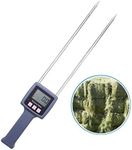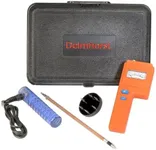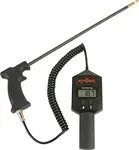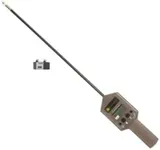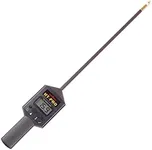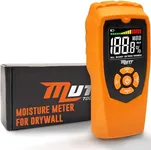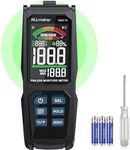Buying Guide for the Best Hay Moisture Meters
Choosing the right hay moisture meter is crucial for ensuring the quality and safety of your hay. A hay moisture meter helps you measure the moisture content in hay, which is important for preventing mold growth and spontaneous combustion. When selecting a hay moisture meter, consider the following key specifications to find the best fit for your needs.Moisture RangeThe moisture range indicates the range of moisture levels that the meter can measure. This is important because different types of hay and storage conditions may require different moisture levels. Typically, a good moisture range for hay is between 8% and 40%. If you are dealing with very dry or very wet hay, make sure the meter can accurately measure those extremes. Choose a meter with a range that covers the typical moisture levels you encounter in your hay.
AccuracyAccuracy refers to how close the meter's readings are to the actual moisture content. This is crucial for making informed decisions about hay storage and usage. Accuracy is usually expressed as a percentage, such as ±1%. Higher accuracy means more reliable readings. If you need precise measurements for high-quality hay, opt for a meter with higher accuracy. For general purposes, a standard accuracy level may suffice.
Probe LengthThe probe length determines how deep the meter can measure moisture within a bale of hay. This is important for getting an accurate reading of the entire bale, not just the surface. Probe lengths can vary from a few inches to over a foot. If you are measuring large bales, a longer probe is beneficial. For smaller bales or spot checks, a shorter probe may be sufficient. Choose a probe length that matches the size of your hay bales and your measurement needs.
Display TypeThe display type refers to how the moisture readings are shown on the meter. Common display types include digital screens and analog dials. A clear and easy-to-read display is important for quickly understanding the moisture content. Digital displays often provide more precise readings and may include additional features like backlighting for low-light conditions. Choose a display type that you find easy to read and understand, especially in the environments where you will be using the meter.
DurabilityDurability refers to how well the meter can withstand the conditions in which it will be used. This is important because hay moisture meters are often used in rugged environments. Look for meters made with sturdy materials and those that are water-resistant or dustproof. If you will be using the meter frequently or in harsh conditions, prioritize durability to ensure a long-lasting tool. For occasional use in controlled environments, standard durability may be adequate.
CalibrationCalibration is the process of setting the meter to provide accurate readings. This is important for maintaining the accuracy of the meter over time. Some meters come with automatic calibration features, while others require manual calibration. Automatic calibration is convenient and ensures consistent accuracy, while manual calibration allows for more control. Choose a meter with a calibration method that suits your preference and ensures reliable readings.
